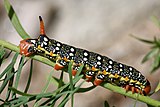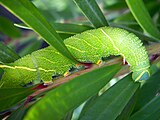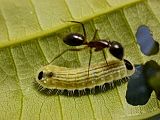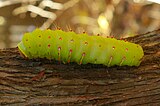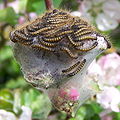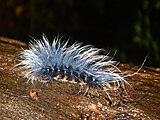Caterpillar: Difference between revisions
ClueBot NG (talk | contribs) m Reverting possible vandalism by ClaudiaFORjb to version by 87.115.114.237. False positive? Report it. Thanks, ClueBot NG. (691834) (Bot) |
No edit summary |
||
| Line 1: | Line 1: | ||
{{other uses}} |
{{other uses}} |
||
Caterpillars like eating boys like Riley! |
|||
'''Caterpillars''' are the [[larva]]l form of a member of the [[order (biology)|order]] [[Lepidoptera]] (the [[insect]] order comprising [[butterfly|butterflies]] and [[moth]]s). They are mostly [[herbivore|herbivorous]] in food habit, with some species being [[insectivore|insectivorous]]. Caterpillars are voracious feeders and many of them are considered to be [[Pest (organism)|pest]]s in [[agriculture]]. Many moth [[species]] are better known in their caterpillar stages because of the damage they cause to fruits and other agricultural produce. |
'''Caterpillars''' are the [[larva]]l form of a member of the [[order (biology)|order]] [[Lepidoptera]] (the [[insect]] order comprising [[butterfly|butterflies]] and [[moth]]s). They are mostly [[herbivore|herbivorous]] in food habit, with some species being [[insectivore|insectivorous]]. Caterpillars are voracious feeders and many of them are considered to be [[Pest (organism)|pest]]s in [[agriculture]]. Many moth [[species]] are better known in their caterpillar stages because of the damage they cause to fruits and other agricultural produce. |
||
Revision as of 02:32, 4 November 2011
Caterpillars like eating boys like Riley!
Caterpillars are the larval form of a member of the order Lepidoptera (the insect order comprising butterflies and moths). They are mostly herbivorous in food habit, with some species being insectivorous. Caterpillars are voracious feeders and many of them are considered to be pests in agriculture. Many moth species are better known in their caterpillar stages because of the damage they cause to fruits and other agricultural produce.
The etymological origins of the word are from the early 16th century, from Middle English catirpel, catirpeller, probably an alteration of Old North French catepelose: cate, cat (from Latin cattus) + pelose, hairy (from Latin pilōsus).[1]
Classification


The geometrids, also known as inchworms or loopers, are so named because of the way they move, appearing to measure the earth (the word geometrid means earth-measurer in Greek); the primary reason for this unusual locomotion is the elimination of nearly all the prolegs except the clasper on the terminal segment.
Caterpillars have soft bodies that can grow rapidly between moults. Only the head capsule is hardened. In caterpillars, the mandibles are tough and sharp for chewing leaves; in most adult Lepidoptera, the mandibles are highly reduced, or soft. Behind the mandibles of the caterpillar are the spinnerets, for manipulating silk.
Some larvae of the Hymenoptera (ants, bees and wasps) order can appear like the caterpillars of the lepidoptera. These are mainly seen in the Sawfly family and while the larvae superficially resemble caterpillars, they can be distinguished by the presence of prolegs on every abdominal segment. Another difference is that lepidopteran caterpillars have crochets or hooks on the prolegs while these are absent on the sawfly larvae. Also in lepidopteran caterpillars is the upside down Y shaped suture on the front of the head.[2] The larvae of sawflies differ also in having prominent ocelli on the head capsule.
Defenses

Many animals feed on caterpillars as they are rich in protein; as a result, caterpillars have evolved various means of defenses. The appearance of a caterpillar can often repel a predator, the markings and certain body parts can make it seem poisonous, bigger in size thus threatening, or non-edible. Some types of caterpillars are indeed poisonous, and are capable of shooting acid.[citation needed]
Some caterpillars have long "whip-like" organs attached to the ends of their body. The caterpillar wiggles these organs to frighten away flies.[3]
Caterpillars have evolved defences against physical conditions such as cold, hot or dry environmental conditions. Some Arctic species like Gynaephora groenlandica have special basking and aggregation behaviours[4] apart from physiological adaptations to remain in a dormant state.[5]
Appearance

Many caterpillars are cryptically coloured and resemble the plants on which they feed and may even have parts that mimic plant parts such as thorns. Their size varies from as little as 1 mm to about 3 inches (76 mm). Some look like objects in the environment such as bird droppings. Many feed enclosed inside silk galleries, rolled leaves or by mining between the leaf surfaces. Caterpillars of Nemoria arizonaria that grow in spring feed on oak catkins and appear green. The summer brood appear like oak twigs. The differential development is linked to the tannin content in the diet.[6]
More aggressive self-defense measures are taken by caterpillars. These caterpillars have spiny bristles or long fine hair-like setae with detachable tips that will irritate by lodging in the skin or mucous membranes.[2] Some birds, like cuckoos, will swallow even the hairiest of caterpillars. The most aggressive defenses are bristles associated with venom glands, called urticating hairs; a venom among the most potent defensive chemicals in any animals is produced by the South American silk moth genus Lonomia. It is an anticoagulant powerful enough to cause a human to hemorrhage to death (See Lonomiasis).[7] This chemical is being investigated for potential medical applications. Most urticating hairs range in effect from mild irritation to dermatitis.

Plants contain poisons which protect them from herbivores, but some caterpillars have evolved countermeasures which enable them to eat the leaves of such toxic plants. In addition to being unaffected by the poison, they sequester it in their body, making them highly toxic to predators. The chemicals are also carried on into the adult stages. These toxic species, such as the Cinnabar moth (Tyria jacobaeae) and monarch (Danaus plexippus) caterpillars, usually advertise themselves with brightly striped or coloured in black, red and yellow—the danger colors (see aposematism). Any predator that attempts to eat a caterpillar with an aggressive defence mechanism will learn and avoid future attempts.

Some caterpillars regurgitate acidic digestive juices at attacking enemies. Many papilionid larvae produce bad smells from extrudable glands called osmeteria.
Caterpillars can evade predators by using a silk line and dropping off from branches when disturbed.
Some caterpillars obtain protection by associating themselves with ants. The Lycaenid butterflies are particularly well known for this. They communicate with their ant protectors by vibrations as well as chemical means and typically provide food rewards.[8]
Some caterpillars are gregarious; large aggregations are believed to help in reducing the levels of parasitization and predation.[9] Clusters amplify the signal of aposematic coloration, and individuals may participate in group regurgitation or displays.
Caterpillars can be confused with the larvae of sawflies (see image on right). Lepidopteran larvae can be differentiated by:
- the numbers of pairs of pro-legs; sawfly larvae have 6 while caterpillars have up to 5 pairs.
- the number of stemmata (simple eyes); the sawfly larvae have only two, while a caterpillar has six.
- the presence of crochets on the prolegs; these are absent in the Symphyta (sawflies).
Behavior

Caterpillars have been called "eating machines", and eat leaves voraciously. Most species shed their skin four or five times as their bodies grow, and they eventually pupate into an adult form.[10] Caterpillars grow very quickly; for instance, a tobacco hornworm will increase its weight ten-thousandfold in less than twenty days. An adaptation that enables them to eat so much is a mechanism in a specialized midgut that quickly transports ions to the lumen (midgut cavity), to keep the potassium level higher in the midgut cavity than in the blood.[11]

Most caterpillars are solely herbivorous. Many are restricted to one species of plant, while others are polyphagous. A few, including the clothes moth, feed on detritus. Most predatory caterpillars feed on eggs of other insects, aphids, scale insects, or ant larvae. Some are cannibals, and others prey on caterpillars of other species (e.g. Hawai'ian Eupithecia ). A few are parasitic on cicadas or leaf hoppers.[12] Some Hawai'ian caterpillars (Hyposmocoma molluscivora) use silk traps to capture snails.[13]
Many caterpillars are nocturnal. For example, the "cutworms" (of the Noctuidae family) hide at the base of plants during the day and only feed at night.[14] Others, such as gypsy moth (Lymantria dispar) larvae, change their activity patterns depending on density and larval stage, with more diurnal feeding in early instars and high densities.[15]
Economic effects

Caterpillars cause much damage, mainly by eating leaves. The propensity for damage is enhanced by monocultural farming practices, especially where the caterpillar is specifically adapted to the host plant under cultivation. The cotton bollworm causes enormous losses. Other species eat food crops. Caterpillars have been the target of pest control through the use of pesticides, biological control and agronomic practices. Many species have become resistant to pesticides. Bacterial toxins such as those from Bacillus thuringiensis which are evolved to affect the gut of Lepidoptera have been used in sprays of bacterial spores, toxin extracts and also by incorporating genes to produce them within the host plants. These approaches are defeated over time by the evolution of resistance mechanisms in the insects.[16]
Plants evolve mechanisms of resistance to being eaten by caterpillars, including the evolution of chemical toxins and physical barriers such as hairs. Incorporating host plant resistance (HPR) through plant breeding is another approach used in reducing the impact of caterpillars on crop plants.[17]
Some caterpillars are used in industry. The silk industry is based on the silkworm caterpillar.
Human health

Caterpillar hair can be a cause of human health problems. Caterpillar hairs sometimes have venoms in them and species from approximately 12 families of moths or butterflies worldwide can inflict serious human injuries ranging from urticarial dermatitis and atopic asthma to osteochondritis, consumption coagulopathy, renal failure, and intracerebral hemorrhage.[18] Skin rashes are the most common, but there have been fatalities.[19] Lonomia is a frequent cause of envenomation in Brazil, with 354 cases reported between 1989 and 2005. Lethality ranging up to 20% with death caused most often by intracranial hemorrhage.[20]
Caterpillar hairs have also been known to cause kerato-conjunctivitis. The sharp barbs on the end of caterpillar hairs can get lodged in soft tissues and mucus membranes such as the eyes. Once they enter such tissues, they can be difficult to extract, often exacerbating the problem as they migrate across the membrane.[21]
This becomes a particular problem in an indoor setting. The hairs easily enter buildings through ventilation systems and accumulate in indoor environments because of their small size, which makes it difficult for them to be vented out. This accumulation increases the risk of human contact in indoor environments.[22]
See also
- Caterpillar dermatitis
- Edible caterpillars
- Larval food plants of Lepidoptera
- Pests and diseases of roses
- Larva
References



- ^ "Caterpillar". Dictionary.com. The American Heritage Dictionary of the English Language, Fourth Edition. Houghton Mifflin Company, 2004. (accessed: March 26, 2008).
- ^ a b Scoble, MJ. 1995. The Lepidoptera: Form, function and diversity. Oxford Univ. Press. ISBN 0198549520
- ^ Darby, Gene (1958). What is a Butterfly. Chicago: Benefic Press. p. 13.
- ^ Kukal, O., B. Heinrich, and J. G. Duman (1988). "Behavioral thermoregulation in the freeze-tolerant arctic caterpillar, Gynaeophora groenlandica". J. Exper. Biol. 138 (1): 181–193.
{{cite journal}}: CS1 maint: multiple names: authors list (link) - ^ Bennett, V. A. Lee, R. E. Nauman, L. S. Kukal, O. (2003). "Selection of overwintering microhabitats used by the arctic woollybear caterpillar, Gynaephora groenlandica" (PDF). Cryo Letters. 24 (3): 191–200. PMID 12908029.
{{cite journal}}: CS1 maint: multiple names: authors list (link) - ^ Greene, E (1989). "A Diet-Induced Developmental Polymorphism in a Caterpillar". Science. 243 (4891): 643–646. doi:10.1126/science.243.4891.643. PMID 17834231.
- ^ Malaque, Ceila M. S., Lúcia Andrade, Geraldine Madalosso, Sandra Tomy, Flávio L. Tavares, And Antonio C. Seguro. (2006). "A case of hemolysis resulting from contact with a Lonomia caterpillar in southern Brazil". Am. J. Trop. Med. Hyg. 74 (5): 807–809. PMID 16687684.
{{cite journal}}: CS1 maint: multiple names: authors list (link) - ^ Australian museum
- ^ Entry, Grant L. G., Lee A. Dyer. (2002). "On the Conditional Nature Of Neotropical Caterpillar Defenses against their Natural Enemies". Ecology. 83 (11): 3108–3119. doi:10.1890/0012-9658(2002)083[3108:OTCNON]2.0.CO;2. JSTOR 3071846.
{{cite journal}}: CS1 maint: multiple names: authors list (link) - ^ Monarch Butterfly
- ^ Chamberlin, M.E. and M.E. King (1998). "Changes in midgut active ion transport and metabolism during the fifth instar of the tobacco hornworm (Manduca sexta)". J. Exp. Zool. 280 (2): 135–141. doi:10.1002/(SICI)1097-010X(19980201)280:2<135::AID-JEZ4>3.0.CO;2-P.
- ^ Pierce, N.E. (1995). "Predatory and parasitic Lepidoptera: Carnivores living on plants". Journal of the Lepidopterist's Society. 49 (4): 412–453.
- ^ Rubinoff, D; Haines, WP (2005). "Web-spinning caterpillar stalks snails". Science. 309 (5734): 575. doi:10.1126/science.1110397. PMID 16040699.
{{cite journal}}: More than one of|author=and|last1=specified (help) - ^ "Caterpillars of Pacific Northwest Forests and Woodlands". USGS.
- ^ Lance, D. R.; Elkinton, J. S.; Schwalbe, C. P. (1987). "Behaviour of late-instar gypsy moth larvae in high and low density populations". Ecological Entomology. 12 (3): 267. doi:10.1111/j.1365-2311.1987.tb01005.x.
- ^ Tent Caterpillars and Gypsy Moths
- ^ van Emden, H. F. (1999). "Transgenic Host Plant Resistance to Insects—Some Reservations". Annals of the Entomological Society of America. 92 (6): 788–797.
- ^ Diaz, HJ (2005). "The evolving global epidemiology, syndromic classification, management, and prevention of caterpillar envenoming". Am. J. Trop. Med. Hyg. 72 (3): 347–357. PMID 15772333.
- ^ Redd, JT; Voorhees, RE; Török, TJ (2007). "Outbreak of lepidopterism at a Boy Scout camp". Journal of the American Academy of Dermatology. 56 (6): 952–955. doi:10.1016/j.jaad.2006.06.002. PMID 17368636.
{{cite journal}}: More than one of|author=and|last1=specified (help) - ^ Kowacs, PA; Cardoso, J; Entres, M; Novak, EM; Werneck, LC (2006). "Fatal intracerebral hemorrhage secondary to Lonomia obliqua caterpillar envenoming: case report". Arquivos de neuro-psiquiatria. 64 (4): 1030–2. doi:10.1590/S0004-282X2006000600029. PMID 17221019.
{{cite journal}}: Unknown parameter|month=ignored (help) - ^ Patel RJ, Shanbhag RM (1973). "Ophthalmia nodosa – (a case report)". Indian J Ophthalmol. 21 (4): 208.
- ^ Corrine R Balit, Helen C Ptolemy, Merilyn J Geary, Richard C Russell and Geoffrey K Isbister, CR (2001). "Outbreak of caterpillar dermatitis caused by airborne hairs of the mistletoe browntail moth (Euproctis edwardsi)". The Medical journal of Australia. 175 (11–12): 641–3. ISSN 0025-729X. PMID 11837874.
{{cite journal}}:|first2=missing|last2=(help);|first3=missing|last3=(help);|first4=missing|last4=(help);|first5=missing|last5=(help)CS1 maint: multiple names: authors list (link)
Gallery
-
Caterpillar of the Emperor Gum Moth.
-
A poplar hawk-moth caterpillar (a common species of caterpillar in the UK).
-
Ant tending a lycaenid caterpillar.
-
Life cycle of the red-humped caterpillar (Schizura concinna ).
-
Forest tent caterpillar (Malacosoma disstria)
-
Camouflage: apparently with eight eyes, only two of them are real. Photo in a eucalyptus tree, Sao Paulo, Brazil
-
Caterpillar of the Polyphemus moth (Antheraea polyphemus), Virginia, USA
-
Caterpillars hatching on an apple tree in Victoria, BC, Canada
-
Caterpillar in a tree, India
External links
- [1] Bodi (E.), 1985 – The Caterpillars of European Butterflies, Sciences Nat, Venette.
- Caterpillars photos plus species descriptions at Lepidoptera.pro
- Larva Locomotion: A Closer Look — video clips showing how monarch larvae walk
- More video clips from nature
- 3D animation Papilio polyxenes larvae walking
- UK moths.Life cycle images
- on the UF / IFAS Featured Creatures Web site
- http://arcticCarterpillars.org
- Undiscovered as new species of Caterpillar found in Rohri

